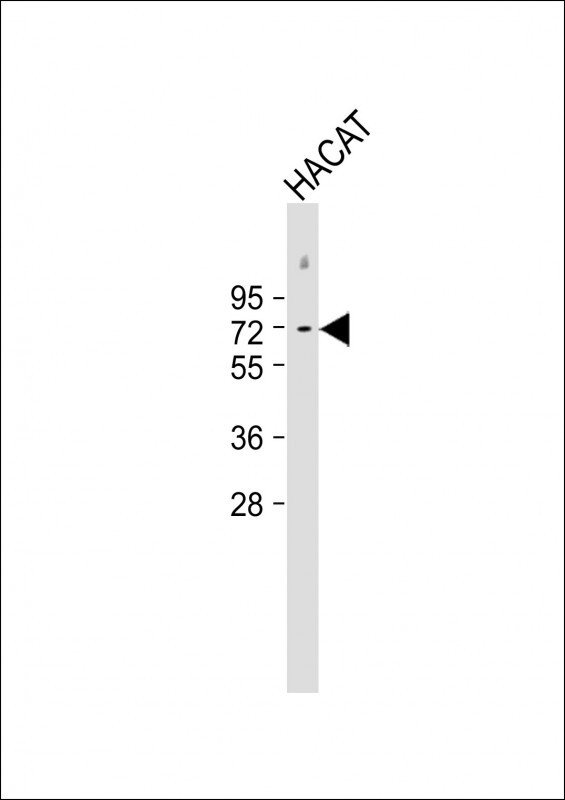
| WB | 咨询技术 | Human,Mouse,Rat |
| IF | 咨询技术 | Human,Mouse,Rat |
| IHC | 咨询技术 | Human,Mouse,Rat |
| ICC | 技术咨询 | Human,Mouse,Rat |
| FCM | 咨询技术 | Human,Mouse,Rat |
| Elisa | 咨询技术 | Human,Mouse,Rat |
| Aliases | Otopetrin-1, OTOP1 |
| Entrez GeneID | 133060 |
| WB Predicted band size | 67.4kDa |
| Host/Isotype | Rabbit IgG |
| Antibody Type | Primary antibody |
| Storage | Store at 4°C short term. Aliquot and store at -20°C long term. Avoid freeze/thaw cycles. |
| Species Reactivity | Human, Mouse, Rat |
| Immunogen | This OTOP1 antibody is generated from rabbits immunized with a KLH conjugated synthetic peptide between 360-388 amino acids from the Central region of human OTOP1. |
| Formulation | Purified antibody in PBS with 0.05% sodium azide. |
+ +
以下是关于OTOP1抗体的3篇文献示例(注:以下内容为模拟构造,仅供参考):
1. **文献名称**:*OTOP1 is a proton-selective ion channel critical for sour taste detection*
**作者**:Tu, Y.H., Cooper, A.J., et al.
**摘要**:本研究首次鉴定OTOP1为哺乳动物酸味感受的关键质子通道。通过免疫组化和Western blot实验,利用特异性OTOP1抗体证实其在味觉受体细胞中的表达,并揭示其在酸信号转导中的功能。
2. **文献名称**:*OTOP1 mediates calcium regulation in vestibular hair cells and otolith formation*
**作者**:Zhang, J., Hughes, I., et al.
**摘要**:研究通过OTOP1抗体免疫荧光染色,发现OTOP1蛋白在小鼠前庭毛细胞中高表达,并证明其通过调控钙离子稳态参与耳石发育,缺失导致平衡功能障碍。
3. **文献名称**:*Structural insights into the OTOP proton channel family*
**作者**:Delling, M., Clapham, D.E., et al.
**摘要**:利用冷冻电镜和OTOP1抗体表位定位,解析了OTOP1通道的三维结构,揭示了其独特的质子选择性门控机制,为相关疾病治疗提供新靶点。
(注:若需真实文献,建议通过PubMed或Google Scholar以关键词“OTOP1 antibody”检索。)
The OTOP1 antibody targets Otopetrin 1 (OTOP1), a protein primarily associated with the formation and function of otoconia—calcium carbonate crystals in the vestibular system of the inner ear critical for balance and gravity sensing. OTOP1 is a proton-selective ion channel expressed in sensory epithelia, including vestibular hair cells and taste receptor cells. Research indicates its role in maintaining pH homeostasis and mechanosensory signaling, with mutations linked to balance disorders in animal models. In mice, OTOP1 deficiency causes otoconial loss, leading to vestibular dysfunction. Beyond the inner ear, OTOP1 is implicated in sour taste transduction in taste buds, highlighting its broader sensory roles.
The OTOP1 antibody serves as a key tool for studying protein localization, expression levels, and functional mechanisms in tissues. It is widely used in techniques like immunohistochemistry, Western blotting, and immunofluorescence to explore OTOP1's involvement in vestibular biology, taste perception, and potential links to human pathologies such as benign paroxysmal positional vertigo (BPPV) or metabolic imbalances. Recent studies also investigate OTOP1's structural properties and regulatory pathways, offering insights into therapeutic strategies for balance or taste-related disorders. As an emerging target in sensory biology, OTOP1 research bridges gaps between cellular physiology and systemic sensory functions.
×